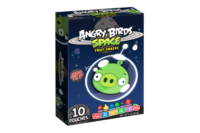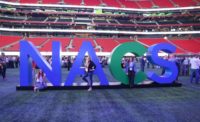These days, when people in the candy industry hear the name Healthy Food Brands, they most likely think of Angry Birds or Candy Crush gummies and fruit snacks. And then, their next thought is probably something along the lines of, “What’s so healthy about those two brands?”
Well, the company didn’t start off making gummies and fruit snacks tied in to mobile games. Rather, in the beginning, they were focused on sugar-free. Thus, back then, the name made sense.
Healthy Food Brands was founded in 1992 by the Asaro family, including Joseph Asaro, and his two sons, Russ and Sal, after they secured the license deal to make Sweet’N Low candy. From there, they made and sold Sweet’N Low sugar-free hard candy and sugar-free chocolate, and by extension became experts in producing sugar-free confections.
In 2009 the company was sold to Abraham Brach who is now the current president and ceo, with Russ Asaro as the executive v.p.
“I stayed on because this business is my passion,” Asaro says.
It was back in 2001, however, when Healthy Food Brands caught its first big break: The low-carb craze went mainstream. And a fundamental part of the lifestyle was eating sugar-free foods — something Healthy Food Brands happened to know a thing or two about.
Suddenly, their products were flying off the shelves, and eventually other companies were working with them through co-packing agreements to manufacture sugar-free confections at their facilities, which they still do to this day.
The company’s Long Island plant, which they’ve had since 1999, can run multiple lines of chocolates and candy. And, Healthy Food Brands also works with outside manufacturers to co-pack other confections.
Then, one day in 2011, Healthy Food Brands got its second big break. Russ Asaro was chatting with a consultant who told him about a mobile game he was really into — Angry Birds.
“I didn’t know much about it,” Asaro recalls.
But based on feedback from the consultant, he had a feeling it could be big, so he called up the Angry Birds chief executive and flew out to meet with him one-on-one — something he wouldn’t even be able to dream of doing today, now that the game is so popular.
The two struck a deal.
“We were one of the original licenses,” Asaro says.
And then, in 2012, the game completely exploded.
“It was really a phenomenon,” Asaro recalls. “It created this whole whirlwind. And it took us completely in a different direction.”
Healthy Food Brands’ first Angry Birds line featured the game’s original characters: Red, Blue, Yellow and Green. Which, like the game, were incredibly popular.
The company’s next line, Angry Birds Space, was just as successful.
The candy maker worked with the game maker and ended up being able to place a special code on the Angry Birds Space boxes that unlocked parts of the game, and the candy also was sold on special displays featuring other Angry Birds’ merchandise.
While those wound up being the best sellers, they’ve also since released other Angry Birds’ lines, including an Angry Birds Star Wars line to correspond with the game by the same name.
Since then, they’ve also come out with Fruit Ninja candy, Cut the Rope candy and even Candy Crush candy.
And so, they’re working on a product that they are confident will be their third big break — a new Welch’s line, which will include freeze-dried fruit, regular dried fruit and an infused cranberry line under the brand name Welch’s.
The freeze-dried fruit is a fast-growing segment. The process means there’s no need for added sugar, and it has a clean label. Freeze-dried fruits also retain 90 percent of the fruits’ nutrients.
The freeze-dried line is slated to include banana, mango, grape, tropical fruit, apple and strawberry slices, and strawberry and banana blend.
Meanwhile, the dried fruit will come in dried apricots, dried mangoes, dried apples and a dried mango, cranberry and blueberry mix. The cranberry-infused line will include: dried cranberries, dried cranberries infused with Concord grape, dried cranberries infused with pomegranate and dried cranberries infused with blueberry.
Asaro expects the products to be ideal for airports, convenience stores and snack aisles in all classes of trade.
However, with a product like freeze-dried fruit, which doesn’t already have a large consumer base, Asaro knows that they’ll have to do plenty of consumer education. That means pull-outs on the packaging and lots of sampling. He’s confident that once people try it though, they’ll be back for more.
“They’ll quickly recognize that it’s a preferred snack,” he explains.
Healthy Food Brands also plans to take its Simply Lite brands to a larger distribution, which already have been a huge success.
Currently, the company offers a dark bar, a dark chocolate with almonds bar and a milk chocolate bar, and it plans to expand the line in 2015.
Healthy Food Brands also plans to expand its private label offerings, which it manufactures at its Long Island plant and warehouse.
Rob Kowitt, director of sales and new business development who started with Healthy Food Brands right after school in July 2001, and has done almost everything at the company, from administrative work in the office to running operations and quality in the plant, says the plant is SQF Level 2 Certified, kosher, and able to produce organic products.
The lines are able to run both sugar and sugar-free candy, but right now all the lines are mostly running sugar-free chocolate.
Currently, they run two 12-hour shifts, five days a week.
“The key to success is a lot of flexibility,’ Kowitt says. “Sometimes, when you’re fully automated, that completely kills your flexibility. We have a lot of experienced employees who have been here a long time. So, we’re able to adjust.”
Just past the offices, in the warehouse area, are rows and rows of product ready to be shipped out, as well as bulk ingredients.
Then, in the manufacturing area, on the far right, there’s the chocolate-molding line, most of which was supplied by Imperial Design.
The process starts off by melting 10-lb. milk chocolate bars in a Blommer melting tank. The dark chocolate is brought in already melted in a tanker truck. Then, depending on the product, one or both of the chocolates are run through the line’s overhead pipes into the tempering unit.
From there the chocolate is sent to the depositor, where it can be combined with a liquid filling or any type of inclusion, such as rice, peanuts or almonds. The chocolates could even be filled with chocolate or placed in peanut butter cup trays and filled with peanut butter.
“Basically, as long as you have the mold, we could make anything,” Kowitt explains.
The chocolate then travels through a cooling tunnel for 30 to 40 minutes. Upon exiting the tunnels, workers segregate the chocolates into single-file lines, so they can be wrapped in the Rimopack machine.
Then other workers grab the exact amount needed for whichever product they are packaging that day. After that, the product is weighed, to double-check that the right number of chocolates are in the box, and then it’s boxed and sent to the warehouse.
The middle line is the cluster line. That process starts by depositing nuts onto caramels. Then, the entire confection is enrobed in chocolate.
And, then, on the far right, is the company’s pride and joy, an automated wafer line — one of the few operating in the entire United States.
The process begins with the mixing of the wafer batter. Major ingredients, such as flour and water, are automatically scaled on the Hebenstreit Rapido line. Once mixed, the batter is deposited onto wafer baking plates.
After a quick bake, the sheets are discharged and conveyed to a cooler, which is arched to ensure they stay straight. Once they’ve cooled, they’re layered with a cream. Then, they’re stored on racks and cooled for about eight hours.
Then, depending on what the customer needs, they can be cut in 1-inch-by-1-inch squares or made into a full wafer bar.
Because wafers are so thin, and easily fall apart, waste is a concern. Moreover, after they’re cooled and sent to be enrobed in chocolate, workers pay special attention to minimize breakage, particularly since that’s when things, “get expensive” as Kowitt explains.
Once they’re enrobed in chocolate, they set for another 10 minutes. Then, they’re packaged and boxed by the workers at the end of the line and ready to ship just like all the other confections.
It’s a sweet process for a company that doesn’t need sugar to be sweet.
At-a-Glance
Simply Natural
Founded: 1992
Sister company: : Simply Natural
Executives: Abraham Brach, Russ Asaro, Rob Kowitt
Headquarters: Brooklyn, N.Y.
Manufacturing facility: 55,000 sq. feet in Long Island, N.Y.
Number of employees: 100
Number of SKUs: More than 100
Website:www.hfbcandy.com


























